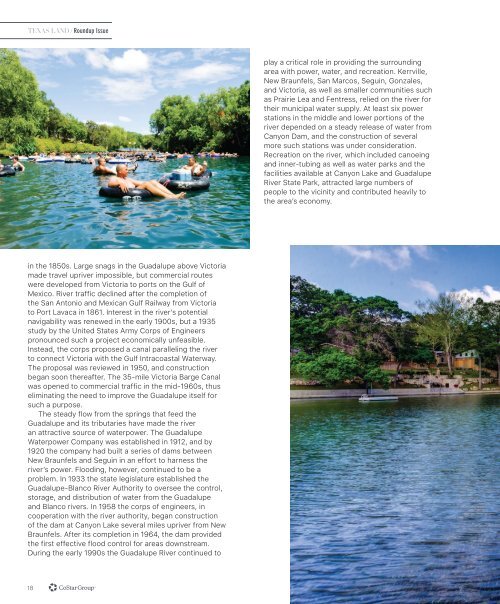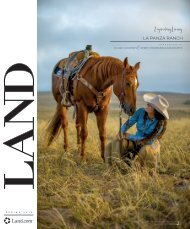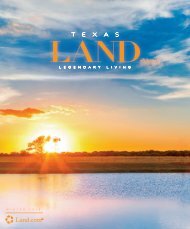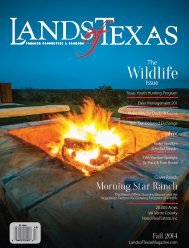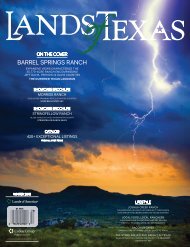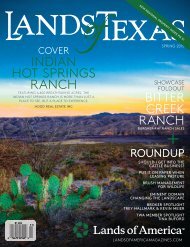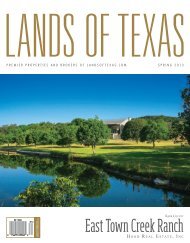Create successful ePaper yourself
Turn your PDF publications into a flip-book with our unique Google optimized e-Paper software.
TEXAS LAND / Roundup Issue<br />
play a critical role in providing the surrounding<br />
area with power, water, and recreation. Kerrville,<br />
New Braunfels, San Marcos, Seguin, Gonzales,<br />
and Victoria, as well as smaller communities such<br />
as Prairie Lea and Fentress, relied on the river for<br />
their municipal water supply. At least six power<br />
stations in the middle and lower portions of the<br />
river depended on a steady release of water from<br />
Canyon Dam, and the construction of several<br />
more such stations was under consideration.<br />
Recreation on the river, which included canoeing<br />
and inner-tubing as well as water parks and the<br />
facilities available at Canyon Lake and Guadalupe<br />
River State Park, attracted large numbers of<br />
people to the vicinity and contributed heavily to<br />
the area’s economy.<br />
in the 1850s. Large snags in the Guadalupe above Victoria<br />
made travel upriver impossible, but commercial routes<br />
were developed from Victoria to ports on the Gulf of<br />
Mexico. River traffic declined after the completion of<br />
the San Antonio and Mexican Gulf Railway from Victoria<br />
to Port Lavaca in 1861. Interest in the river’s potential<br />
navigability was renewed in the early 1900s, but a 1935<br />
study by the United States Army Corps of Engineers<br />
pronounced such a project economically unfeasible.<br />
Instead, the corps proposed a canal paralleling the river<br />
to connect Victoria with the Gulf Intracoastal Waterway.<br />
The proposal was reviewed in 1950, and construction<br />
began soon thereafter. The 35-mile Victoria Barge Canal<br />
was opened to commercial traffic in the mid-1960s, thus<br />
eliminating the need to improve the Guadalupe itself for<br />
such a purpose.<br />
The steady flow from the springs that feed the<br />
Guadalupe and its tributaries have made the river<br />
an attractive source of waterpower. The Guadalupe<br />
Waterpower Company was established in 1912, and by<br />
1920 the company had built a series of dams between<br />
New Braunfels and Seguin in an effort to harness the<br />
river’s power. Flooding, however, continued to be a<br />
problem. In 1933 the state legislature established the<br />
Guadalupe-Blanco River Authority to oversee the control,<br />
storage, and distribution of water from the Guadalupe<br />
and Blanco rivers. In 1958 the corps of engineers, in<br />
cooperation with the river authority, began construction<br />
of the dam at Canyon Lake several miles upriver from New<br />
Braunfels. After its completion in 1964, the dam provided<br />
the first effective flood control for areas downstream.<br />
During the early 1990s the Guadalupe River continued to<br />
18


